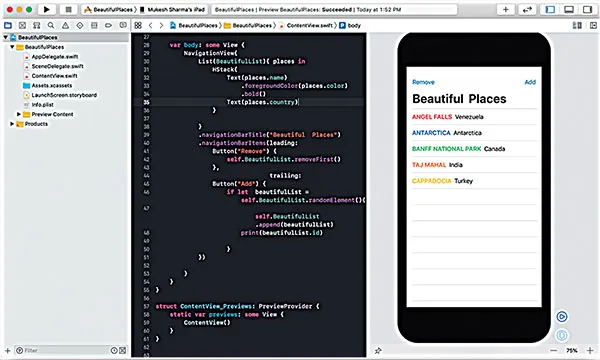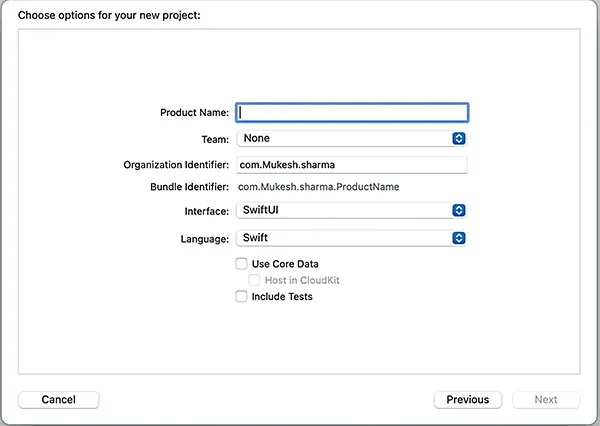
iOS Development with SwiftUI
Acquire the Knowledge and Skills to Create iOS Applications Using SwiftUI, Xcode 13, and UIKit
- English
- ePUB (mobile friendly)
- Available on iOS & Android
iOS Development with SwiftUI
Acquire the Knowledge and Skills to Create iOS Applications Using SwiftUI, Xcode 13, and UIKit
About this book
Learn iOS Programming Using SwiftUI Framework and Xcode
Key Features
? Demonstrates numerous examples using the SwiftUI concepts.
? A step-by-step walkthrough of the lifecycle of an Xcode 13 project.
? Access to SwiftUI development challenges and expert solutions.
Description
'iOS Development with SwiftUI' focuses on teaching and practicing the use of SwiftUI for developing iOS applications that leverage the latest iOS features.To begin, the book covers the fundamentals of SwiftUI and its core functionalities and how to write UI without having to worry much about it. It explains the fundamental Swift syntax, data types, control statements, functions, classes, and structures, as well as methods, protocols, and closures. The book covers expert tips for adding animations with a single line of code, as well as some SwiftUI transitions. Then, through a dissection of an iOS application, it teaches how to create APIs and implement API calls. It also covers widgets, App Clip development, web banner creation, and how the app communicates with the App Clip.The book will help demonstrate how to integrate XCTest into your application for both UI and unit testing and how to write your test case and prepare the application for general use.At the end of the book, you will be able to write an iOS application in SwiftUI and gain some experience to call API or web services using combine.
What you will learn
? Learn to use the feature 'Combine' in the application and call various APIs.
? Understand data flow and stacks, including VStack, HStack, and ZStack.
? Understand and practice how to share the data between the app and extensions.
? Work with the latest iOS features such as App Clip and Widgets.
? Become well versed with Xcode 13 and UIKit while using it with SwiftUI.
Who this book is for
This book caters to SwiftUI developers, iOS developers, and students who want to build good proficiency in the entire process of iOS application development. Knowing basic programming concepts would be good, although not mandatory.
Table of Contents
1. What is SwiftUI
2. Basics of Swift
3. Anatomy of the Basics of SwiftUI Projects
4. Introduction to SwiftUI Basic Controls and User Input
5. State Properties, Observable, Environment Objects, and Combine Framework
6. Stacks of Views Using VStack, HStack, And ZStack
7. Work with Lists and Navigation.
8. SwiftUI with UIKit
9. UIKit with SwiftUI
10. UI Logic of the MVVM Architecture and Networking
11. Drawing in SwiftUI
12. Animations and Transitions in SwiftUI
13. App Clip
14. Widgets
Frequently asked questions
- Essential is ideal for learners and professionals who enjoy exploring a wide range of subjects. Access the Essential Library with 800,000+ trusted titles and best-sellers across business, personal growth, and the humanities. Includes unlimited reading time and Standard Read Aloud voice.
- Complete: Perfect for advanced learners and researchers needing full, unrestricted access. Unlock 1.4M+ books across hundreds of subjects, including academic and specialized titles. The Complete Plan also includes advanced features like Premium Read Aloud and Research Assistant.
Please note we cannot support devices running on iOS 13 and Android 7 or earlier. Learn more about using the app.
Information
CHAPTER 1
What is SwiftUI?
Introduction
Structure
- Introduction to SwiftUI
- The SwiftUI architecture
- Opaque types
- SwiftUI for all Apple products
Objective

Technical requirements for running SwiftUI

Introduction to SwiftUI
UIViewController, not even a UIView. Text is a struct, and View is just a protocol. A SwiftUI View is extremely lightweight.Declarative
let labelText = UILabel(frame: CGRect(x:0, y:0, width:120, height:120))labelText.text = “Understanding SwiftUI”labelText.textColor = UIColor.redlabelText.backgroundColor = UIColor.greenlabelText.font = UIFont(name: “Consolas”, size: 26)self.view.addSubview(labelText)Text(“Understanding SwiftUI”).foregroundColor(.blue).background(Color.red).font(.largeTitle)
refresh.SwiftUI will refresh the UI.Automatic
build.SwiftUI preview and also shows our designs in multiple screen sizes at the same time. This speeds up development.The SwiftUI architecture
Table of contents
- Cover Page
- Title Page
- Copyright Page
- Dedication Page
- About the Author
- About the Reviewer
- Acknowledgements
- Preface
- Errata
- Table of Contents
- 1. What is SwiftUI?
- 2. Basic of Swift
- 3. Anatomy of a SwiftUI projects
- 4. Introduction to SwiftUI Basic Controls and User Input
- 5. State Properties, Observable, Environment Objects, and Combine Framework
- 6. Stacks of Views Using VStack, HStack, And ZStack
- 7. List and Navigation
- 8. SwiftUI in UIKit
- 9. UIKit in SwiftUI
- 10. Animation and Transitions
- 11. Drawing in SwiftUI
- 12. MVVM and Networking Using Combine
- 13. App Clip
- 14. Widgets
- Index